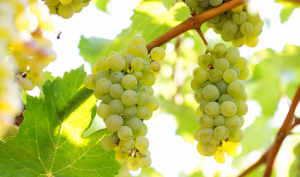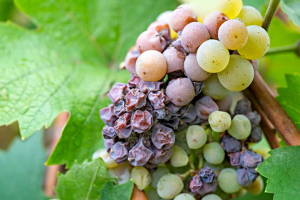A few issues back we discussed Pinot Noir Tasting. That was supposed to be a one-off, because that grape is so ubiquitous and yet so different as you traverse Wine Country. Then we thought about Syrah. So we at Power Tasting decided to make a new series, investigating wine tasting from the perspective of different varietals.
We have often experienced tastes of Sauvignon Blanc as the first offering on any given California winery’s tasting list for the day. To be honest, it’s not our favorite, but what are we supposed to do when a nice server just puts a glass of it in our hands as we walk into the tasting room? For the most part, California winemakers tend to favor very fruity Sauvignon Blancs. Maybe too much so, in our opinion, so we tend to dismiss wines made from those grapes.
 Sauvignon Blanc grapes. Photo courtesy of the Wine Institute.
Sauvignon Blanc grapes. Photo courtesy of the Wine Institute.
Now, it’s not that we never buy or enjoy California Sauvignon Blancs. We enjoy Dry Creek Vineyard’s version on hot summer days and Robert Mondavi’s all year long (except they call it Fumé Blanc). If that were all there were to it, we’d consider these wines pleasant pastimes, but nothing to take seriously.
Our mistake.
Sauvignon Blanc has such a different character in France (or really, multiple characters) that it’s hard to recognize French wines made from that grape as being related to their California cousins. Let’s start in the Loire valley, where Sancerre is as austere (almost to the point of sourness) as California Sauvignon is fruit-forward (almost to the point of sweetness). For many people, Sancerre is the wine of choice to match the brininess of raw oysters, totally unlike any California Sauvignon Blancs.
The French do make things confusing, though. Another widely popular Loire wine is Vouvray, but it’s made from Chenin Blanc. And then there’s Pouilly Fumé from the Loire, which is Sauvignon Blanc and Pouilly Fuissé from Burgundy, which isn’t. (It’s Chardonnay.)
In Bordeaux, Sauvignon Blanc is one of the two primary grapes in Sauternes. (The other is Semillon.) In this case, the wines aren’t almost sweet; they’re very decidedly honeyed.
 Shriveled grapes to be made into Sauternes wine. Photo courtesy of Winetraveler.
Shriveled grapes to be made into Sauternes wine. Photo courtesy of Winetraveler.
There’s nothing quite like wine tasting in the Sauternes region, which also includes the village of Barsac. It’s a day spent drinking dessert. The grapes aren’t as pretty; they’re all shriveled by the botrytis fungus that concentrates the sugars and adds an indescribable sensation to the taste of the wine. But the castles and the grand châteaux are wonderful and the food is delicious.
In Italy, they make wine from Sauvignon Blanc all over the country, especially in the northeastern part, but they just call the grape Sauvignon. Frankly, they’re not the white wines that Italy is famous for.
They are famous for Sauvignon Blanc in New Zealand, where we’ve visited but not had the chance to go wine tasting. The Kiwi white wines are also very (maybe two very’s) fruit forward, the fruits in question often being citrus and pineapple. These wines are not to everyone’s taste, but they certainly put New Zealand on the map of Wine Country, so that’s something to be proud of.
A little fruity, a lot fruity, maybe sour, definitely sweet. That’s some grape, Sauvignon Blanc!